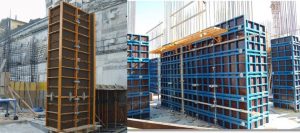Raw material characteristics of poplar plywood
Poplar is a fast-growing tree species with a short growth cycle and high yield, making it an ideal wood resource. Its wood is light and soft, with a uniform fiber structure, easy to process and low price. In addition, poplar resources are widely distributed in northern my country, with the advantages of being renewable and sustainable, which provides a solid foundation for the large-scale production of poplar plywood.
Manufacturing process of poplar plywood
1.Raw material preparation
-Material selection: High-quality poplar wood is the key. Usually, poplar logs with no pests and diseases, uniform growth, and tough wood are selected.
-Cut: Cut the poplar logs into lengths and diameters suitable for peeling, so as to facilitate the next step of peeling or planing into veneers.
2.Veneer production
-Peeling and softening: Peel off the logs and soften them by steam heating. The temperature is usually controlled at 100-120℃. The heating time is adjusted according to the size of the logs to make the wood fibers soft and conducive to peeling.
-Peeling or planing: The softened logs are processed into veneers (thin wood sheets) with uniform thickness by peeling machines or planing machines. The thickness of the veneers is generally about 1.5~3 mm.
-Air drying: The veneers are air-dried or dried to reduce the moisture content, generally controlled between 8%-12%, to prevent deformation or degumming during gluing.
3.Grading and trimming of veneers
-Check the quality of veneers and remove parts with defects such as knots, cracks, discoloration, etc.
-Trim the surface of veneers to ensure that the board surface is flat and the size is uniform.
4.Gluing
-Select a suitable adhesive, commonly used are phenolic glue, urea-formaldehyde glue or polyvinyl glue, etc. The specific selection is customized according to product performance requirements and environmental protection standards.
-Use a rubber roller or glue spraying equipment to evenly apply the adhesive on the surface of the veneer.
5.Gluing and laminating
-According to the designed plywood structure, the veneers after gluing are staggered and stacked in the direction of the grain (usually an odd number of layers: 3 layers, 5 layers, 7 layers, etc.) to enhance the strength and stability of the plywood.
-Pay attention to the cross-grain direction when laminating. Usually, the grains of adjacent veneers are arranged vertically to resist deformation.
6.Hot Pressing
-Put the laminated plywood into the hot press, press and cure at a certain temperature (generally 120-150℃), pressure (about 1-2 MPa) and time (several minutes to more than ten minutes) to fully cure the adhesive and firmly bond the veneers into a whole board.
-The hot pressing process directly affects the density, strength and water resistance of the plywood.
7.Cooling and shaping
-After hot pressing, the plywood needs to be cooled to room temperature to prevent deformation caused by thermal expansion and contraction.
-Trimming and splicing the finished product to ensure dimensional accuracy and flatness.
8.Surface treatment
-Sanding, coating or laminating the surface of the plywood as needed to improve the appearance and durability.
-Moisture-proof, fire-proof or anti-corrosion treatment can also be performed to meet different application requirements.
9.Quality inspection and packaging
-Test technical indicators such as strength, moisture content, flatness, adhesion, etc., and only after passing the test can it be packaged and shipped.
-Pay attention to moisture and pressure during packaging to facilitate transportation and storage.
Summary of CUZI Industry key technical points
*Raw material selection: The quality of poplar directly affects the performance of plywood.
*Softening process: Steam softening process parameters determine the quality and production efficiency of veneer.
*Adhesive selection: Environmentally friendly and stable adhesives are the core of ensuring product quality.
*Hot pressing process control: Temperature, pressure and time are related to the structure and performance of plywood.
*Quality control: Strict inspection of the entire process is the prerequisite for ensuring the qualified rate of plywood.
Poplar Plywood VS Birch Plywood
| Features | Poplar Plywood | Birch Plywood |
| Raw material characteristics | Poplar grows fast, has abundant resources, is light and soft, and has low cost | Birch is harder, has fine texture, and has better strength and toughness |
| Physical properties | Relatively light, low density, moderate strength, and average impact resistance | High density, high strength, good impact resistance and wear resistance |
| Processing performance | Easy to process, easy to cut and nail | More difficult to process than poplar, but more delicate molding effect, smooth surface |
| Water resistance | Strong water absorption, special treatment is required to improve moisture resistance | Low water absorption, good natural moisture resistance |
| Environmental protection | Poplar has abundant resources and a short growth cycle, which is more environmentally friendly | Birch has a long growth cycle and relatively limited resources |
| Price | Low cost, economical and practical | Higher price, suitable for high-end products |
| Application | Suitable for general indoor furniture, packaging, temporary structural materials | Mostly used for high-end furniture, interior decoration, handicraft production |
Poplar plywood and birch plywood each have their own advantages. Poplar plywood is widely used in general construction and furniture manufacturing due to its low cost and abundant resources; while birch plywood is suitable for high-end customization and fields with strict performance requirements due to its superior physical properties and beautiful texture. When purchasing, users should reasonably choose the appropriate plywood product based on specific application needs, budget and performance requirements.
The core competitiveness of CUZI Industry poplar plywood
Poplar plywood occupies an important position in the fields of construction, furniture manufacturing and packaging due to its unique material properties and process advantages.
1.Lightweight and economic advantages
-Lightweight (density 0.4-0.5g/cm³), 20%-30% lighter than pine/birch plywood, greatly reducing transportation and construction costs
-Significant price advantage, 30%-50% lower than similar products, is the most cost-effective engineering board
-Especially suitable for: high-rise building formwork, logistics packaging, temporary facilities and other scenes that require frequent handling
2.Excellent processing performance
-The fiber structure is uniform and delicate, and it is not easy to collapse the edge when cutting/drilling. The CNC processing accuracy can reach ±0.2mm
-Excellent surface finish (Ra≤3.2μm), can be directly UV coated or PVC coated
-The nail holding strength reaches 1100N/mm², which is better than most cork plywood
-Woodworking-friendly material, which can improve processing efficiency by more than 30%
3.Environmentally friendly and sustainable development
-Poplars can be mature in 5-8 years and are FSC-certified sustainable forestry resources
-MDI formaldehyde-free adhesives can be used, and the formaldehyde emission is ≤0.03mg/m³ (exceeding the E0 standard)
-The carbon footprint is 40% lower than that of hardwood plywood, meeting the requirements of LEED green building certification

